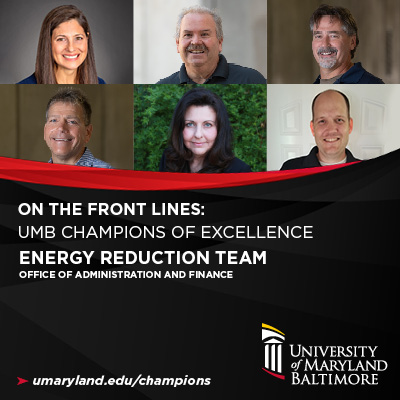On the Front Lines: UMB Champions of Excellence: Energy Reduction Team
December 02, 2020 Lou Cortina
Taking advantage of low population density on campus, six-member team implemented climate control changes and other measures in University buildings to save $2 million-plus and counting.
The Champions of Excellence campaign is a multiyear branding campaign at the University of Maryland, Baltimore (UMB) in which we highlight individuals and teams that exemplify extraordinary accomplishment and represent excellence at the University. This year, UMB is highlighting the employees who've done exemplary work since the COVID-19 pandemic unfolded in March. During the next few months, The Elm will be featuring these UMB Champions, who are making Baltimore, our region, and in some cases the world a better place.
Today: Energy Reduction Team, Office of Administration and Finance
The COVID-19 pandemic has created an economic crisis for colleges and universities around the country. At the University of Maryland, Baltimore (UMB), a six-person team of Facilities and Operations (F&O) employees is doing its part to ease the pandemic’s budgetary effects.
Taking advantage of the limited population density on campus, the Energy Reduction Team in F&O, which is a branch of the Office of Administration and Finance, has implemented energy-saving measures throughout UMB buildings, particularly research facilities. From mid-April to mid-November, these actions have saved the University about $2.1 million, resulting in team members being honored as UMB Champions of Excellence.
Nazanin Fouladi, MA, associate vice president, F&O, named Melissa Morland, MS, MBA, as the team’s project manager once the pandemic unfolded. Morland was newly hired in F&O as director of operations and maintenance but was well-acquainted with UMB, having worked for Environmental Health and Safety for 21 years.
“Melissa coming on board, coupled with COVID, gave us a perfect opportunity to drive forward these changes,” Fouladi said. “I know no one’s thinking COVID was the ‘perfect opportunity,’ but it was an accelerator for change. We have multiple plants on campus, and the low occupancy made it the perfect time for our great technical experts to test their theories on how to more effectively manage our operations. We are saving a little over $10,000 a day.”
(Watch video below.)
Because 90 percent of the campus’ energy output is used in research buildings, the team focused its efforts on reducing steam and electric usage in those spaces, working with research teams to limit hours of operation unless it was critical research. “That allowed the building automation team to go in and reprogram different spaces and buildings in regard to things like heating and hot water reduction,” Fouladi said.
UMB’s chilled water plants produce the biggest electrical expense in the summer, so reducing chilled water and hot water demand across campus was a key part of the plan. The temperatures of the air supplied for conditioning and ventilation were marginally increased while hot water temperatures were lowered, reducing the negative effect of simultaneous overcooling the air supply and then overheating room temperatures. This effort allowed the team to question the “canned algorithms” built into its air distribution and space heating systems and optimize their energy efficiencies.
“We reduced that methodology in office buildings to 100-degree water on the low end and 120 on the high end, and labs are doing 110 on the low end and 130 on the high end,” said Matthew Hazel, building automation systems manager, who coordinates HVAC systems operations remotely. “Reducing the chilled water demand of our core research buildings while still maintaining comfort for all users generated the largest electrical savings during the hottest summer days.”
Fouladi, Morland, and Hazel have worked remotely, while the three other team members remain on-site: Mike Krone, MS, assistant director, utilities management; Jim Bolton, safety training and special projects specialist; and Kevin E. Smith, assistant director, mechanical systems.
“Our team did a lot of work and pushed the envelope, but we also had so much buy-in and support from our campus customers,” Morland said. “There were a lot of people who came up with great suggestions and solutions.”